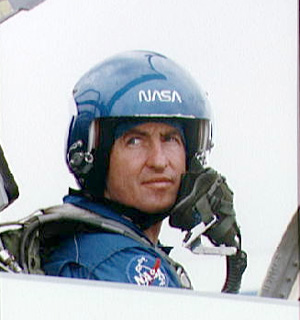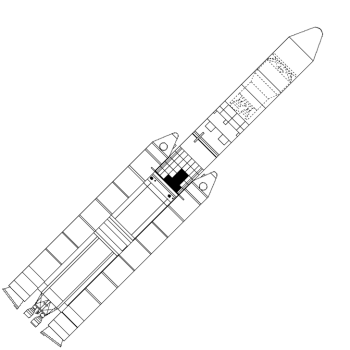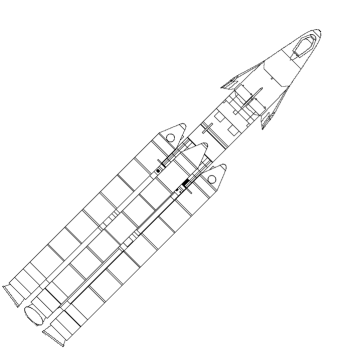Actually, what I think may happen during the 1980's is that instead of a big Space Shuttle carrying cargo, we'll have small spaceplanes developed during the 1980's that carry up seven astronauts to the Soviet and American space stations. The American version will be launched on top of an uprated Saturn 1B rocket, while the Soviet version will be launched from the ATL version of the Proton rocket.
I'd like to see some spaceplanes, at least experimental ones to demonstrate the advantages of the concept--which mainly boil down to, lower acceleration during descent and greater control of the landing point, as well as the possibility of horizontal airplane-like landings--which mean, if you've returned to an airfield at the launch point, saving the cost of picking it up wherever in the ocean or tundra it came down in and hauling to some base. This is mostly important if you plan to reuse said spaceplane, which is not necessarily a given but one of the major reasons to try and develop them.
But our properly trained astronautical gurus on this site are generally dismissive of them, pointing out that a capsule will always be lighter for a given mission, that returning to a chosen landing site is largely a matter of scheduling reentry correctly, that unless we are so expanding space travel to orbit (or very long range suborbital flights, which are tantamount to orbit almost in terms of the speeds we need to attain and endure on reentry) to the degree that ticket-buying passengers are common our space travelers will continue to be elite, highly trained specimens of robust young to middle-aged adults who can take 5 or 6 G's of stress, and reuse of spacecraft, particularly the manned orbiters that will be a small fraction of the total launch stack in mass, is marginal and questionable...So if they are right an experimental program will bear out their skepticism and focus efforts on making more capable capsules and ingenuity in making the big launchers somewhat more efficient.
And I'm afraid that ITTL, you are off base as to which launchers could do the job, at least on the Soviet side. The Kremlin never approved continuing the UR-500 program so there is no Proton derivative of it here; its place is filled on the high end by the N-11, which we've just recently been told is not launching any more manned craft (though that's a decision that could easily be reversed) and I guess on the low end by stretches of the old Semyorka/R-7 family. Now in OTL these stretches were minimal, involving increasing payloads to orbit by a few tons at most, and this may reflect limits in the design that are reached by the existing designs. In that case perhaps they'd look instead to downsizing the N-11 further; I recently wondered what would happen if we dropped both the lower stages off the N-1 and got answers in the ballpark of an R-7 performance, so that's a viable direction to go. All we know is, not a Proton, and given the Proton's hypergolic fuels I say Thank God for that.
On the American side--well, we've gotten teasers that the Americans are developing something intermediate, but we haven't been told what. Those of us who are deeply impressed with e of pi & Workable Goblin's work with their take on a Saturn 1C, leading to the Multibody family, can hardly imagine a superior or even comparable alternative to these, and pretty much replicating their work with a 1C is entirely in the cards here, since the F-1A and J-2S engines which were the key to them are being built and used for the Saturn VB. But perhaps the authors here have something quite different up their sleeves, we don't know yet.
Just replicating the capabilities of the Saturn 1B, without surpassing it, leaves quite a launch vehicle.
On the other hand, the Saturns in general were criticized for being expensive. Well, if you want to launch 100 tons and more to low Earth orbit, obviously you need a big rocket and it isn't clear to me how much the admittedly high price tag of a Saturn V launch is due simply to the fact that it's 5 or 6 times bigger than anything you need for any more mundane purpose than Moon missions; I think the critics are saying it is pricy even if we divide the cost by 6, that is alternative rockets with proven economics could, with multiple launches, loft the same payload for a lower overall price. If the latter is true, I think it is mainly a matter of economics of scale--the smaller workhorse rocket is called upon to play many roles and so it is produced in a larger volume and on a more regular basis, hence can profitably be provided to the agencies that use it at a lower sticker price.
What is this competitive workhorse? OTL, it was none other than the Titan family, starting with a scarcely altered Titan II ICBM that served to loft the Gemini capsules into orbit, to be followed up by the solid-boosted Titan III originally designed--well, precisely to put a spaceplane, namely Dyna-Soar aka X-20 into orbit, later repurposed for MOL and Big Gemini. None of these dreamed of manned Air Force missions ever flew OTL and they were probably cancelled ITTL as well, for the same reasons, although the question of why Big Gemini, perhaps launched on a Saturn 1B instead of a Titan III, was ruled out would be an interesting passage for the authors to shine some light on.
As someone who looks askance on hypergolic launchers, I'd be glad to see the Titan option bypassed for manned spaceflight myself. But I can't deny that OTL on both sides of the Iron Curtain hypergolic rockets, namely the Protons and the Titans, were indeed the classic workhorses of both superpowers when they wanted to launch something moderately heavy and unmanned. I'd rather see all scheduled launches of payloads, manned and unmanned alike, replaced by ker-lox or other alternatives to hypergolics, reserving these for orbital maneuvering and landing and takeoff from small bodies like the Moon, and even there replaced if at all possible--but the thing is, unless one could demonstrate that kerosene-hydrogen peroxide launchers were competitive with hypergolics for weapons purposes (that is, missiles), the hypergols win in that application except insofar as solid rockets can replace them. And procurements for operational weapons systems are going to be large, larger than all but the most grandiose space program, so the economics of scale favor the hypergols (unless we can replace them with peroxide-kerosine, as the theoretical numbers suggest to me we ought to be able to but the real engine development I've been able to track down leaves in some doubt). The hypergolic missiles can sit in storage, waiting to be launched at a moment's notice with relatively minimal maintenance, almost like solids and superior to them in some ways; you can't do that with liquid oxygen as the oxidant.
So if both sides wind up avoiding dependency on hypergolics I'd call that a minor miracle, one that would please me, but not necessarily the respective offices of management and budget, nor the lobbying axis of the military and their hypergolic-supplying contractors who will be a force to reckon with, in Washington or Moscow.
But we could wind up with an amusing reversal with the Soviets launching everything into orbit on various ker-lox rockets and the Americans falling back on Titan derivatives.

For what it's worth, I think McNamara did the right thing in canceling Dyna-Soar as an Air Force project--I have yet to hear of a plausible explanation what its military mission would have been. What I wish is that NASA had been given the mandate, and enhanced budget, to develop it instead, launching it on Saturn 1B or some successor thereof. It is NASA's job, as successor to the old National Advisory Committee on Aeronautics (NACA) to push the theoretical frontiers of flight back with experimental craft, and undertake the cost of testing out various out-there concepts to see which ones prove worth pursuing--and that is what Dyna-Soar might have accomplished. If proving and improving the technology led to a plausible Air Force mission, that would be the time for the Pentagon to then order such a craft. Meanwhile perhaps Dyna-Soar would indeed lead to cost-effective improvements in the civil space program and conceivably to practical suborbital commercial flight for paying passengers.
OTL, before the Politburo got spooked by reports that the STS, which the Air Force had reluctantly agreed to back provided it met some extreme specifications they laid out, would indeed have unspecified military capabilities and therefore decided to play it safe by replicating it, at budget-breaking cost, the Soviets were busily working on several quite different approaches to spaceplanes and/or reusuable spacecraft. If there is no STS here, I daresay that at least some of these alternative approaches will get some funding from the Kremlin and result in hardware, perhaps going beyond OTL to manned orbital missions on some of them (OTL a couple full-sized Burans were launched and landed, automatically, but never piloted)--and if the Soviets succeed in that, presumably there will be an American lobby that seeks to catch up, or better yet preempt them with American designs. But whether they are suitable replacements for Apollo or a belated restart of Big Gemini as orbital shuttle craft for manned missions remains to be seen.



